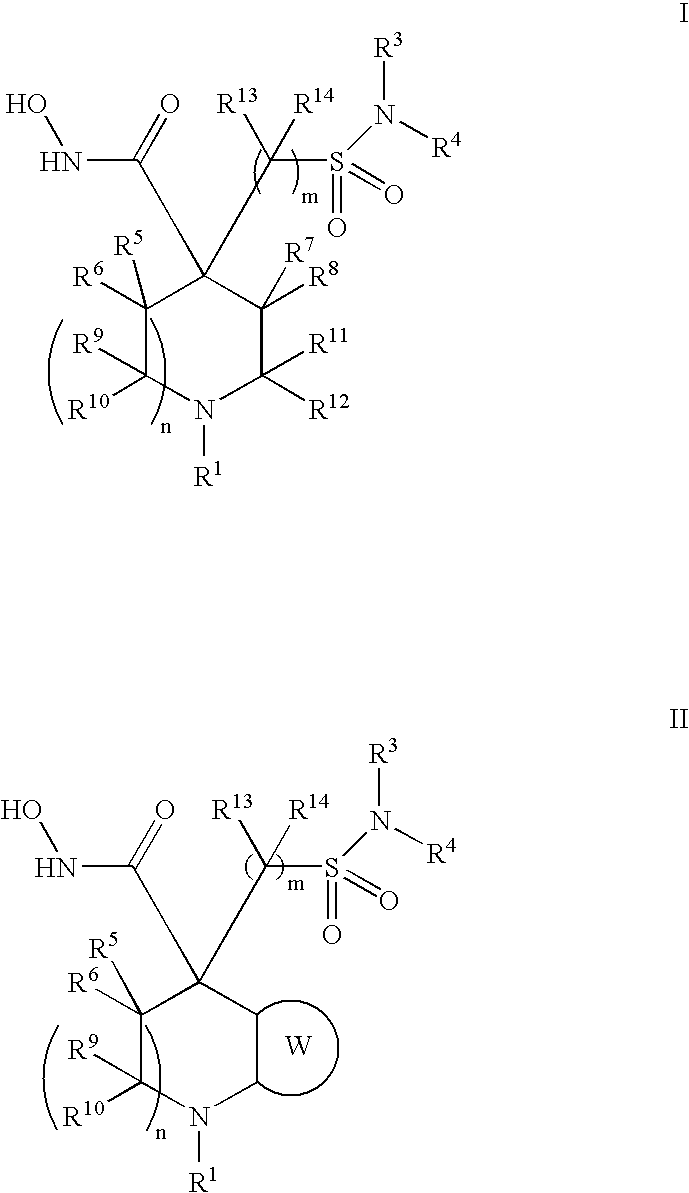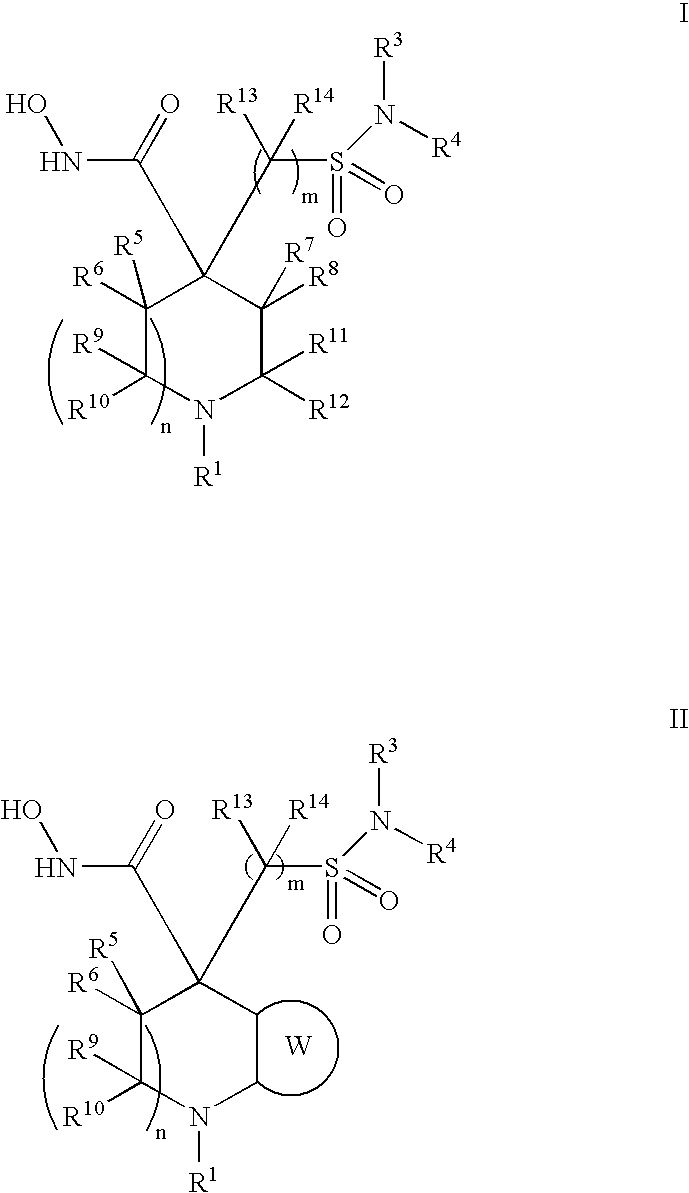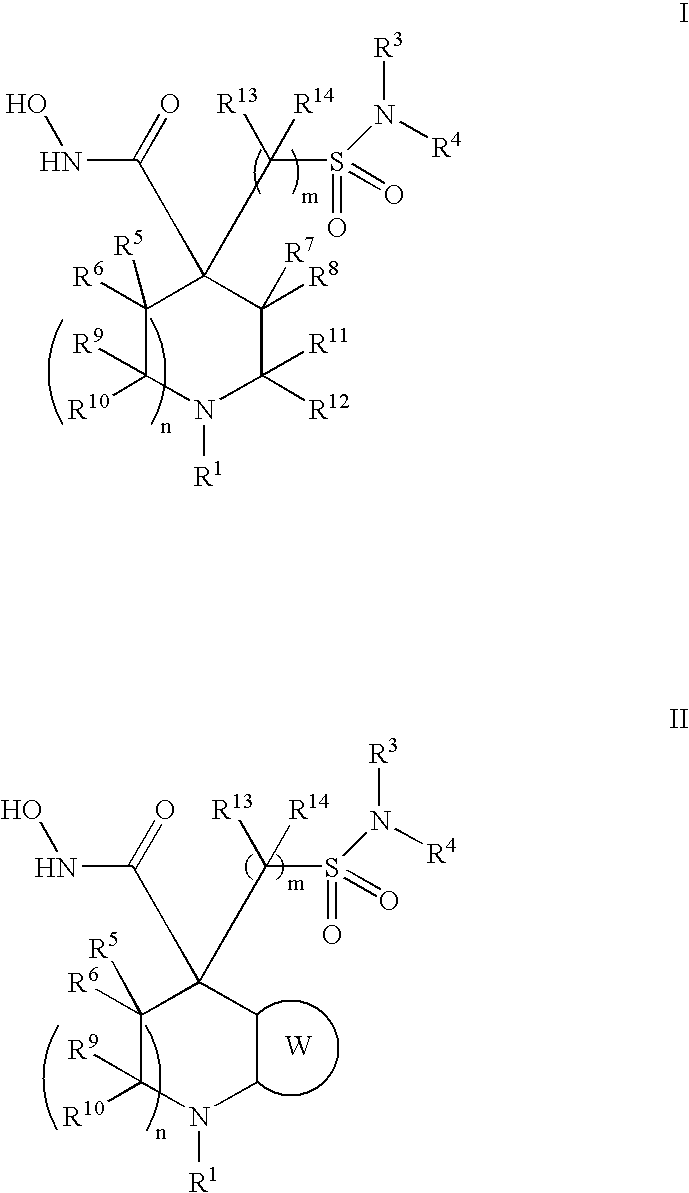Hydroxamic acid derivatives as metalloprotease inhibitors
a technology of hydroxamic acid and metalloprotease, applied in the field of 4hydroxamic acid piperidines, can solve the problems of loss of regulation, excessive proteolysis of extracellular matrix by another, and undesirable tissue destruction
- Summary
- Abstract
- Description
- Claims
- Application Information
AI Technical Summary
Benefits of technology
Problems solved by technology
Method used
Image
Examples
example 1
4-[4-(4-Cyano-2-methyl-phenyl)-3,6-dihydro-2H-pyridine-1-sulfonylmethyl]-4-hydroxycarbamoyl-piperidine-1-carboxylic acid-3(S)-tetrahydrofuran-3-yl ester
[0287]
Step A
(S)-3-THF 4-nitrophenyl carbonate
[0288] To a stirred solution of p-nitrophenyl chloroformate (6.0 g, 0.029 mol) in anhydrous methylene chloride (60 mL, 1 mol) at 0° C. were added (S)-(+)-3-hydroxytetrahydrofuran (2.44 mL, 0.0302 mol) and 4-methylmorpholine (4.8 mL, 0.043 mol). The reaction mixture was stirred at rt for 4 h. The reaction mixture was quenched with water (50 mL) and extracted with dichloromethane (2×), and the combined organic layers were washed with brine, dried over MgSO4, filtered and concentrated in-vacuo. The residue was purified by Combiflash with 20-40% EtOAc / Hex.
Step B
4-Methyl 1-[(3S)-tetrahydrofuran-3-yl]piperidine-1,4-dicarboxylate
[0289] To a solution of (S)-3-THF 4-nitrophenyl carbonate (0.20 g, 0.00079 mol) in dimethyl sulfoxide (4.0 mL, 0.056 mol) were added methyl piperidine-4-carbox...
example 2
4-[4-(4-Cyano-2-methyl-phenyl)-piperidine-1-sulfonylmethyl]-4-hydroxycarbamoyl-piperidine-1-carboxylic acid-3(S)-tetrahydrofuran-3-yl ester
[0298] Into a vial were added (3S)-tetrahydrofuran-3-yl 4-([4-(4-cyano-2-methylphenyl)-3,6-dihydropyridin-1(2H)-yl]-sulfonylmethyl)-4-[(hydroxyamino)carbonyl]piperidine-1-carboxylate (3.6 mg, see Example 1) and methanol (2.0 mL). To this solution, palladium (5 wt % on barium sulfate, reduced, Aldrich# 27,299-1) was added under an atmosphere of nitrogen. The reaction mixture then was purged with H2(g) and the mixture was stirred under hydrogen (balloon) for 1.5 hours. The reaction mixture was filtered through Celite and washed with methanol. The filtrate was concentrated to give the desired product. LC-MS: 535.2 (M+H)+
example 3
4-Hydroxycarbamoyl-4-(4-phenyl-3,6-dihydro-2H-pyridine-1-sulfonylmethyl)piperidine-1-carboxylic acid-3(S)-tetrahydrofuran-3-yl ester
[0299] This compound was prepared substantially as described in Example 1 except starting from 4-methyl 1-[(3S)-tetrahydrofuran-3-yl] 4-[(chlorosulfonyl)methyl]piperidine-1,4-dicarboxylate and 4-phenyl-1,2,3,6-tetrahydropyridine. LC-MS: 494.2 (M+H)+
PUM
| Property | Measurement | Unit |
|---|---|---|
| Ri | aaaaa | aaaaa |
| Ri | aaaaa | aaaaa |
| Ri | aaaaa | aaaaa |
Abstract
Description
Claims
Application Information
 Login to View More
Login to View More - R&D
- Intellectual Property
- Life Sciences
- Materials
- Tech Scout
- Unparalleled Data Quality
- Higher Quality Content
- 60% Fewer Hallucinations
Browse by: Latest US Patents, China's latest patents, Technical Efficacy Thesaurus, Application Domain, Technology Topic, Popular Technical Reports.
© 2025 PatSnap. All rights reserved.Legal|Privacy policy|Modern Slavery Act Transparency Statement|Sitemap|About US| Contact US: help@patsnap.com



